
by Scott Vitter and Corey James Friday, July 14, 2017
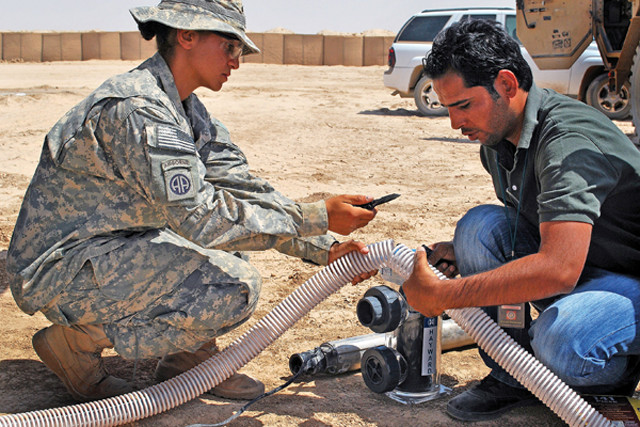
Water is run through a solar-powered water filtration system at Forward Operating Base (FOB) Hammer in Iraq. Credit: U.S. Army photo by Pvt. Jared Gehmann.
The U.S. military is spread across more than 500 installations worldwide, from small Forward Operating Bases (FOBs) in Afghanistan and Iraq that resemble remote villages without water treatment or sanitation infrastructure, to large domestic bases that operate like established municipalities with aging infrastructure. No matter the size or location of a particular installation, though, the military needs a lot of water.
Finding solutions to water shortages and other problems is, thus, already an important mission for the U.S. Department of Defense (DOD). And given its scale and resources, as well as its need for resilient systems, the department is poised to drive innovation in the water sector. DOD’s efforts could have far-reaching benefits beyond the military.
DOD has managed water systems for more than 200 years, supplying water at precise times and places, including some of the most austere and unforgiving environments in the world. Existing innovations — such as desalination plants in arid locations and rugged reverse osmosis purification units, which purify contaminated and saline water into drinking water and can be safely dropped from an airplane — have aided these efforts. But, on the whole, much more can and should be done to position the military to lead the world in developing sustainable, resilient water systems.
The U.S. military has extensive experience managing water systems, including many dams, reservoirs, canals and critical transportation arteries like the Mississippi River through the U.S. Army Corps of Engineers — the steward of American waterways; through its operating bases worldwide; and through its efforts to bring water to places that have been devastated by natural disasters or that otherwise lack clean drinking water. Placing a departmental emphasis on innovation in municipal water systems is new for the military, but the task plays to its historical strengths.
Two critical tools are already in place. The first is ample funding. DOD is the largest grantmaking agency in the U.S. government, awarding about half of all federal money allotted for research and development. The second existing tool is the network of federally funded research and development centers that support DOD initiatives. In addition, the Army, Navy and Air Force each maintain their own research labs. These institutions have long histories of providing technical solutions to military problems — solutions that in some cases have gone on to have civilian applications around the world. Technologies like radar, the Global Positioning System, the internet, and even driverless cars have benefited from research originally performed for the military.
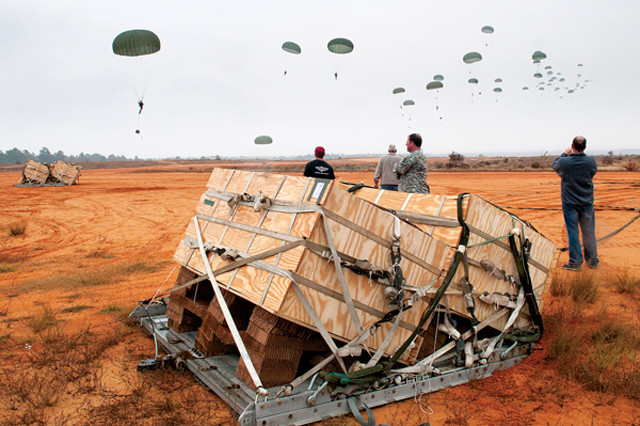
A test water drop at Camp Mackall in North Carolina: These CUBEs, or Container Unitized Bulk Equipment, are used to drop water and other supplies into FOBs and outposts. Credit: Sgt. Michael J. MacLeod/U.S. Army.
Military product specifications are stringent and innovations can be very costly and/or lack usefulness in broad nonmilitary applications. However, military innovations have also yielded technologies that change the world. As DOD moves forward to innovate in the water sector, it should prioritize procuring technologies that also have the potential to be low-cost and societally beneficial down the road.
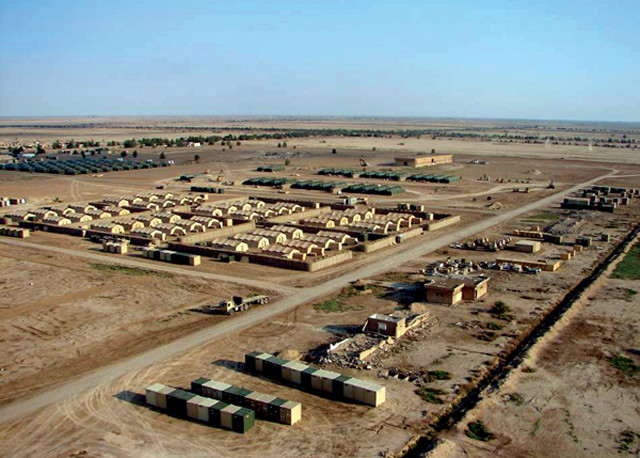
FOB Hammer in Iraq. Credit: U.S. Air Force.
Civilian application of some current water-saving innovations, like on-site rainwater capture systems for homes and businesses, has been limited by nontrivial, upfront costs to purchase and install these systems and by long payback periods. Water is not expensive enough to make these investments attractive in the general marketplace. This limitation is understandable, but it should not necessarily apply to the military, for which capability and functionality drive purchasing and acquisitions more than price. DOD pays top dollar for the right weapons and ballistic armor for soldiers, and the same should be true for water-related technologies that make military installations more resilient and less dependent on external infrastructure. The ability to operate independently from civilian infrastructure when needed is valuable to the military. Projects and initiatives in this direction should thus be prioritized, even if it means accepting longer returns on investment.
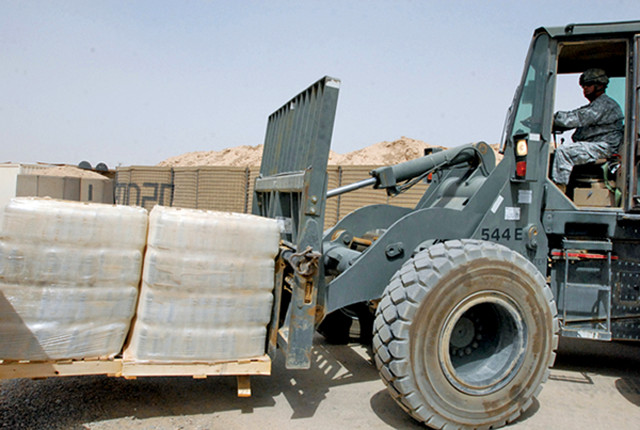
According to the U.S. Army, an average of 864,000 bottles of water were needed each month to keep soldiers on FOB Warrior in Kirkuk, Iraq, hydrated during operations in the 2000s; that number nearly doubled in the summer months. Credit: Pfc. Justin Naylor, 2nd Brigade Combat Team, 1st Cavalry Division Public Affairs.
The military also has a unique ability to enter into long-term contracts (up to 20 years) with companies innovating in the water sector. Having DOD as a long-term customer gives innovative technology providers the first market they need to grow their production, achieve economies of scale, and expand their business to nonmilitary applications.
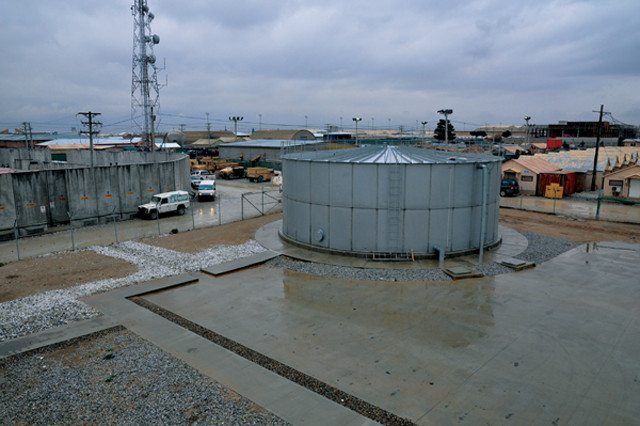
A $41.7 million water infrastructure upgrade built by the U.S. Army Corps of Engineers at Bagram Airfield in Afghanistan includes nine 211,000-gallon water storage tanks. Credit: Paul Giblin/U.S. Army.
Water supplies are vital to the success of any military operation, and programs like the Army’s Net Zero Initiative — the signature conservation and sustainability campaign in DOD — show that the military is already changing the way it thinks about and relates to water, energy and waste. Launched in 2010, the water component of Net Zero includes eight pilot installations representing a diversity of geographic, climatic, and weather-related conditions across the U.S. and Puerto Rico.
The goals of Net Zero Water are two-fold: By 2020, each pilot installation should 1) reduce the intensity of freshwater use by 50 percent relative to 2007 (quantified as total gallons of freshwater consumption per square foot of gross building area); and 2) reduce industrial, landscaping and agricultural water consumption by 40 percent relative to 2010. The Army hopes these goals will transform installations by reducing their freshwater consumption while also promoting strategies that eventually return water to the same watershed, avoiding depletion of regional water resources in the long term. The initiative is flexible, allowing installation managers to develop their own solutions, and will cultivate a database of “lessons learned” for other installations to duplicate (or avoid) in the future.
The Army’s Net Zero program has produced some outstanding results in its first seven years. For example, at Fort Carson in Colorado, the base began recycling wastewater in 2014 to avoid consuming potable water for irrigation. The project diverts millions of gallons of wastewater, treats it to the watershed standard, and uses it to irrigate critical areas at the installation. A similar story is unfolding at Tobyhanna Army Depot in Pennsylvania, where the Army combined its wastewater-recycling-for-irrigation project with upgrades to a water chiller in a large industrial facility. This saves the depot more than 2.3 million gallons of potable water each month. Both of these projects, funded by the Army Working Capital Fund, had high upfront costs but paid for themselves in a matter of months. They have also saved the embedded cost of treating, purchasing, storing and conveying potable water.
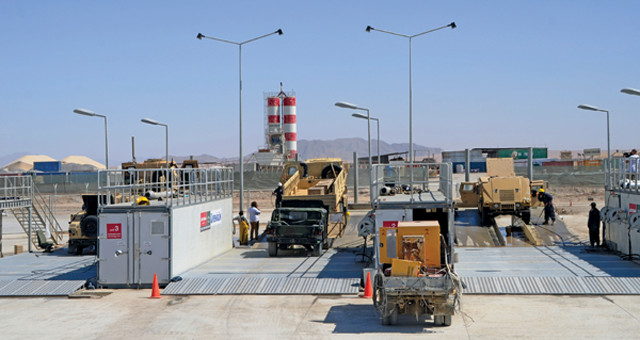
Maintaining Army vehicles involves cleaning them at washing stations after they have been in the field, as shown here at Joint National Maintenance Facility in Kandahar, Afghanistan. Recognizing the burden that washing vehicles places on water resources, the Army is working on recycling and reusing the water. Credit: Summer Barkley/U.S. Army.
Another success story comes out of Fort Riley in Kansas. To keep Army vehicles in working order, they are habitually washed and cleaned after field training exercises. Recognizing the burden that washing vehicles places on water resources, Fort Riley established a series of filtering ponds to recycle water in a closed loop and return it for eventual reuse. The practice saves hundreds of thousands of gallons of water each year.
Several encouraging projects have also been undertaken across other branches of the military. At California’s Camp Pendleton, the Marine Corps recently implemented a device called a sequencing batch reactor (SBR), which supplies reclaimed wastewater for irrigation and groundwater recharge. SBRs have the potential to be more energy-efficient than conventional activated sludge wastewater treatment processes while also maintaining high standards for wastewater reclamation. At Dyess Air Force Base in Texas, the Air Force partnered with the city of Abilene to repurpose pipelines originally built to transport oil. Today, the pipelines supply Dyess with about 160 million gallons of Abilene’s treated wastewater each year. The treated water is used for irrigation, allowing the base to reduce its purchases of drinking water. This partnership has helped Abilene reduce freshwater demand by 2 percent while saving the Air Force more than $300,000 annually. These projects are not first of their kind, but they indicate that military installations are becoming concentration points for sustainable infrastructure.
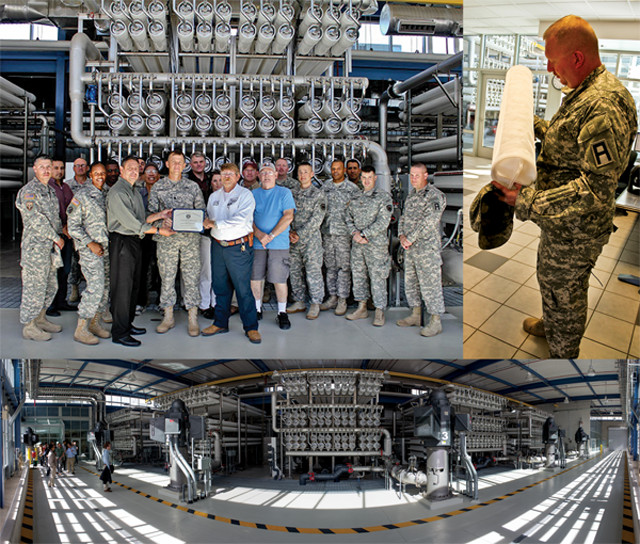
The Kay Bailey Hutchison Desalination Plant on Fort Bliss, an Army base in Texas, is the largest inland desalination plant in the world. Although it operates at only about 15 percent of its capability, the plant has the capacity to meet all of the base's water needs, as well as those of much of the city of El Paso. Credit: top two: 1st Lt. Vanessa Dudley, 1st Battalion, 361st Engineer Regiment, 5th Armored Brigade, Division West Public Affairs; bottom: Webber Energy Group/Jeffrey M. Phillips.
That isn’t to say there aren’t challenges remaining at military bases. The water situation at the Army base at Fort Bliss offers a good example of the challenges and innovation opportunities that DOD should embrace. In a water-starved part of southwest Texas, the Army and the city of El Paso made news when they cooperated to build a $90 million groundwater desalination facility. The Kay Bailey Hutchison Desalination Plant opened in 2007 to address water needs driven by population growth, ongoing drought, and water scarcity. A decade later, it is still the world’s largest inland facility of its kind.
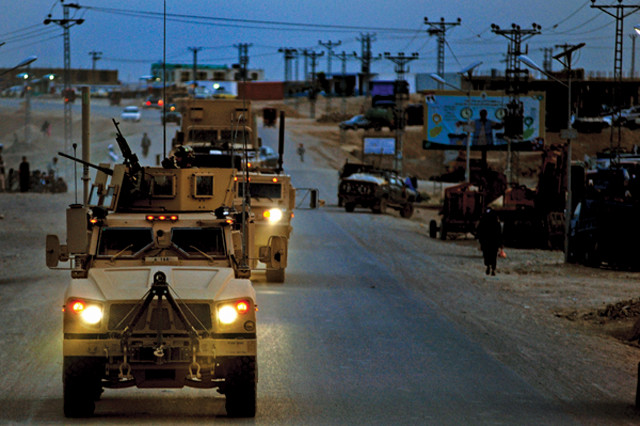
A resupply convoy in Afghanistan. By adopting new technologies, FOBs can remain effective while lessening requirements for resupply convoys that place soldiers in harm's way. Credit: U.S. Army.
The plant has the capacity to supply the entire water demand on the base in addition to much of El Paso’s demand. However, since opening, it has only operated at about 15 percent of full output. The energy requirements of desalination make the plant a costly source of potable water, so the Army rarely operates it at full capacity. Fort Bliss will need to start relying on the plant’s water supply more heavily if the goal is to become self-sufficient as part of the Army Net Zero Initiative. But the base will also need to make efforts to reduce freshwater consumption, such as by embracing advanced irrigation systems, xeriscaping, and water-efficient appliances in on-base housing. Even more can be done to prevent water losses and more thoroughly identify water-consuming processes on the base. By combining both supply-side and demand-side solutions to meet water-related goals, Fort Bliss can be a leader in water management strategies.
An emphasis on water systems in the deployed environment is also showing up in DOD labs. Air Force and Army research labs have recently unveiled “Forward Operating Base of the Future” concepts to pilot technical solutions to common challenges posed by remote deployment environments — water being chief among them. For example, the U.S. Army Natick Soldier Research, Development & Engineering Center is developing technologies for condensing water out of ambient air and recycling wastewater. If successful, both technologies might transform how FOBs procure water, allowing remote outposts to move away from a dependency on external deliveries and toward self-sufficiency. By adopting new technologies, FOBs can remain effective while lessening requirements for resupply convoys that place soldiers in harm’s way.
Emphasizing conservation, in addition to searching for alternative sources of water, is another area where military installations can show leadership to become truly “net zero.”
Innovative water solutions that the military develops can be tailored for both military operations and humanitarian operations, and the latter means bearing nonmilitary applications in mind. Military equipment is often very expensive, custom manufactured, highly complex, and used only for short periods. These are minor drawbacks for DOD, which is well funded and has good reason to emphasize performance over, say, cost or simplicity of use. To maximize the nonmilitary applications of water-related technologies and solutions, however, DOD should emphasize affordability, durability, and simplicity in addition to achieving technical specifications. This emphasis should lead DOD to focus research and development, procurement, and operations on technologies that either promote resilient water infrastructure domestically or increase access to clean drinking water and sanitation services in remote locations with limited infrastructure.
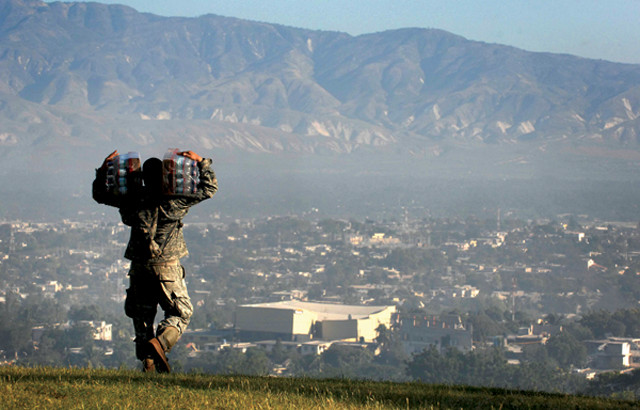
The U.S. military frequently steps in to bring medical care and much-needed supplies when disasters strike, such as the January 2010 earthquake in Haiti. Credit: U.S. Army.
Innovative water solutions are good for sustainability, and they’re also good for national defense. For example, if the military reduced its dependence on bottled water for deployments in Iraq and Afghanistan, it could reduce convoys along routes peppered with improvised explosive devices, meaning fewer casualties.
More broadly, embracing innovations related to water and wastewater management could also benefit the nearly 2 billion people facing water scarcity around the world. Conducting an informal search, we identified at least 11 water-related conflicts that have occurred in the past two years worldwide in areas already vulnerable to turbulent governance and terrorism. Water scarcity is destabilizing, but solutions to bring water security and sanitation services to more people can be a force for peace and stability. Thus, the potential benefits of solving water challenges include making the military a more effective fighting force in the short term, and helping resolve, prevent or mitigate new conflicts in the future.
The military already focuses on “operational energy” — the energy requirements to train, move, and sustain military personnel and equipment around the world. DOD needs to place a similar emphasis on “operational water,” the water needed to sustain its operations worldwide. Elevating water to the same status as energy within the department will garner more political support and resources for water-system innovation.
The potential impacts of DOD focusing on water treatment and sanitation technology could rival those of other remarkable technologies born from defense research and development. In urban areas, successful water-system innovation will bring abundant supplies with fewer negative environmental impacts. In remote or rural areas, successful innovation will help finish the work begun by the U.N. Millennium Development Goals: aid those without clean drinking water (748 million people) and basic sanitation services (2.5 billion people) to gain access to these fundamental needs.
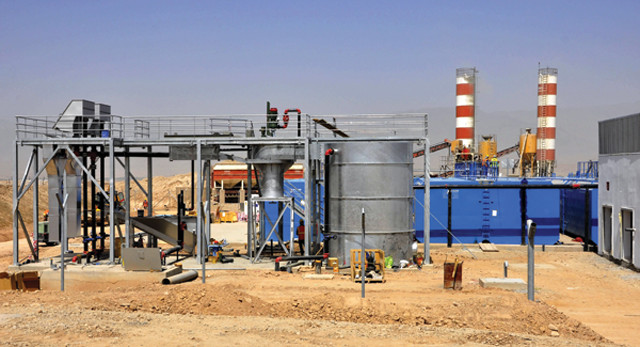
The U.S. Army Corps of Engineers built a highly efficient wastewater treatment plant at FOB Tarin Kowt in Afghanistan. Credit: U.S. Army Corps of Engineers photo by Mike Beeman.
DOD has the research capacity, purchasing power, and self-interest to be a force in water-system innovation. And programs like the Net Zero Initiative and the Forward Operating Base of the Future project show that the department and the military are heading in the right direction. Moving forward, these efforts should be expanded to demonstrate continuing leadership in the development of resilient and sustainable water systems.
© 2008-2021. All rights reserved. Any copying, redistribution or retransmission of any of the contents of this service without the expressed written permission of the American Geosciences Institute is expressly prohibited. Click here for all copyright requests.